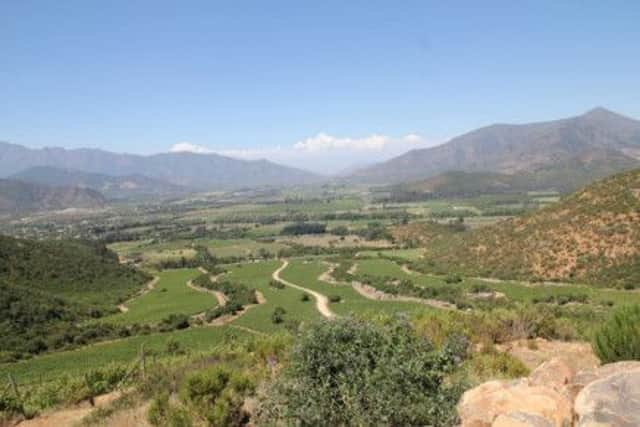Wine Club: The perfect location


It was while Don Maximiano Errazuriz was travelling between Chile’s capital city, Santiago and the coastal port of Valparaiso that he found a piece of land in the Aconcagua Valley which he thought would be perfect for growing grapes. Other producers of that time, in the late 1800s, had clustered their vineyards around Santiago, but Don Max was looking for the right land in the right place, and Panquehue, around two days ride from the capital was it.
With no established workforce in the area, Don Max ended up building a small village to house vineyard workers – very much in the same way as Joseph Rowntree built houses for his workers in York.
Advertisement
Hide AdAdvertisement
Hide AdSkip forward five generations and Eduardo Chadwick, a direct descendant of Don Max, is still searching out the best land for his vines. Those vineyards established by Don Max are still there, although now there is a gleaming, modern winery. Eduardo has continued the journey, seeking out even better sites along the valley, which runs east west between the mountains and the sea, with a river running through it, taking meltwater from the Andes. So not only is there water here, there is a corridor for cool coastal air.
It was a natural choice, when searching for the right place for an upmarket wine, that Eduardo decided that this same valley, closer to the sea, was ideal. Originally a joint venture with Robert Mondavi but now a personal project of Eduardo, the Seña vineyard is just 25 miles from the sea. Here the daytime temperatures are still warm enough to ripen the mix of Cabernet Sauvignon, Merlot, Carmenere, Petit Verdot and Cabernet Franc, but cool enough, especially on the hillsides to benefit from those cooling breezes to keep the flavours fresh. Tucked into a corner of the hillside thrown up in the creation of the Andes, there is a different soil for each variety and the land has been shaped to work with nature. Organic since 2001 and biodynamic since 2005 there are corridors for wildlife to roam through the vineyards. Viticulturalist Jorge Figueroa explains, “This site and this way of working makes the grapes and the wine unique.”
The three vintages I tasted over lunch showed an evolution in style from concentrated, slightly dusty, evolved, rounded flavours (2000) to intense, smooth, precise, harmonious blackberry fruit with touches of liquorice, spice, minerality and pure finesse (2012). Clearly this is a wine that will mature and develop. Currently available at £300 for six bottles of the 2012 (Berry Bros) this is a wine to buy now, tuck away and bring out in five to 10 years, although I suspect that it could be drinking well even in 20 years time.
Continuing further down the valley, just seven miles from the chilly Pacific Ocean, the new vineyards of Manzanar, known as Aconcagua Costa, are now in production. This is rolling countryside with a distinct cool breeze keeping temperatures down and making this a perfect site for Errazuriz Aconcagua Costa Sauvignon Blanc. The 2014 was poured for tasting and it was like a refreshing shower for the tastebuds, minerally, fresh and citrus with vibrant, lively flavours, but smooth and refined on the palate. There is a picture of an ammonite on the label that links the sea, minerals and the vineyard location. Waitrose has the 2013 vintage, which is drinking exceptionally well, priced £11.99. Pinot Noir and Chardonnay are also being grown on this site and the wines are just making their way into shops. I drank the 2013 Pinot Noir (around £18) with seared tuna and it was fantastic. Look out for these wines.
Advertisement
Hide AdAdvertisement
Hide AdEduardo did not have to go far to find his prized vineyard for the wine that bears his family name – Viñedo Chadwick comes from his father’s former polo field a short stroll across an immaculate lawn from his old house. In the old changing room there are pictures on the wall showing a young Duke of Edinburgh with Alfonso Chadwick and silver trophies galore, but when Eduardo wanted to grow grapes there, Alfonso eventually agreed. Now the polo field is winning prizes again, this time for its wines. Planted to Cabernet Sauvignon, this flat land is situated on an old river bed, and a grave-like hole dug in the vineyard shows layers of large rounded stones and gravel with vine roots weaving their way deep into the soil. “This is good for the vines”, said Eduardo, “because it is very well drained and the roots have to go down deep to survive.”
Viñedo Chadwick has regularly hit the headlines with its winning form in the series of blind tastings known as the “Berlin Tastings”. Starting in 2004, Eduardo has pitted his wines, blind, against the top wines of the world. In 2004 Viñedo Chadwick 2000 came out top, with Seña 2001 second, beating Ch. Lafite Rothschild 2000 and Margaux 2001. I was privileged to take part in the London event and it was fascinating to see Chilean wines stand shoulder to shoulder with the grand names of Bordeaux, Italy and California. At each tasting, in London, Berlin, Tokyo, New York, Beijing, Moscow and around the world, Eduardo’s Viñedo Chadwick, Seña and Don Maximiano have been judged worthy of being in the same company as the established grand names of wine.
It is unlikely that Don Maximiano ever thought that a wine bearing his name would be so well known and regarded, but by seeking out the right land for his vines he set the standard for the generations that followed.
Try the top wines for very special occasions, but look out for the regular Errazuriz wines too. One of my favourites is Errazuriz Max Reserva Cabernet Sauvignon 2012 (Waitrose £12.99). Concentrated, elegant and smooth it has red berries, cinnamon and clove notes. Perfect for winter drinking.